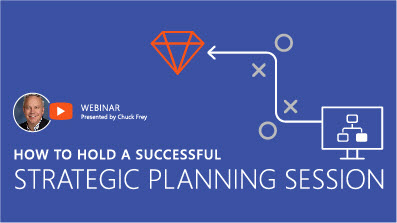By: Chuck Frey (Guest Blogger)
Join us for our upcoming webinar with Chuck Frey on August 7th, titled “How to Hold a Successful Strategic Planning Session”. Register today!
Imagine this scenario: You’re facilitating a strategic planning session with the brightest minds in your company. Standing in the front corner of the room to your left is an enormous block of granite, tall enough that it just misses the fluorescent lights in the meeting room. Your ace team of strategic planners are shouting out ideas. Chisel in one hand and a hammer in the other, you capture them on the face of the granite slab.
Does this sound ridiculous? Of course it does!
The shortcomings of traditional (linear) strategic planning tools
But consider that recording ideas and managing a strategic planning process using flipcharts and whiteboards isn’t much more efficient than using stone tablets. These media, which have been relatively unchanged for decades, aren’t very efficient. Here’s why:

- Once you record an idea on a whiteboard or flip chart, it’s “anchored” in place. You can’t move or group it with related ideas easily.
- Much of the information captured on these media is in the form of words. This is limiting, because it forces the group to think in a linear mindset that assures they won’t stray too far from the status quo.
- Your “canvas” is fairly small. Once you’ve filled a flip chart sheet, you must tape or pin it to a wall of your meeting room. A white board, once it’s full, can only be erased – after someone photographs it to capture the group’s thinking. As the meeting progresses, those ideas are lost from view – a real momentum killer.
- At the end of the meeting, the facilitator must transcribe the morass of ideas captured and transform them into a form that can be shared with the team. Here’s how Alex Gooding, an Australian consultant who specializes in governance, strategic planning and organization management, describes this antiquated process: “At the end of day there will be the time-consuming process of transcribing, collating and summarizing all of this material. Eventually, the outcomes will be circulated to the workshop participants for comment. By that time, many of them will have forgotten the event – or worse yet, they might feel that the record differs significantly from their memories of what was said during the planning sessions. As a result, they may become disengaged from the outcomes, and more importantly may lack ownership of the resulting strategic plan.”
Today’s more complex business challenges cry out for an alternative approach that is flexible, efficient and keeps team members engaged. It also needs to help the planning team to think divergently, so they can consider and discuss new possibilities and opportunities. And in today’s agile business environment, it needs to be powerfully efficient.
The solution is to adopt a visual approach to strategic planning.
How mind mapping software enhances strategic planning
Mind mapping software is an especially powerful visual tool that meets these needs and can inspire teams to think at a higher level. Here are some of the ways it can enhance your next strategic planning session:
Team members can see their ideas captured – in context.
As team members share ideas and insights, the facilitator can quickly capture them in the mind map. The idea contributor can immediately see whether or not the facilitator captured their idea accurately. More importantly, they can see it in context of other ideas.
In addition, viewing all of the ideas on screen can often inspire team members to generate additional ideas based on them – a powerful brainstorming technique called “plussing.” It can transform ideas with a modest amount of value into game changers.
Speed: The facilitator can maintain the team’s creative momentum, even if the flow of ideas increases, because mind mapping software enables him or her to capture ideas fast, and organize them later. Many mind mapping programs have brainstorming modes that enable their users to capture ideas fast, using only the keyboard. Also, the facilitator doesn’t have to stop the flow of ideas to capture and then erase a full white board, or to rip a full flip chart sheet off of the pad and attach it to the wall. That’s a big plus!
Multiple ways to group related ideas visually.
As the strategic planning team transitions from brainstorming to making sense of all of the ideas captured, mind mapping software provides a rich toolset to help them to visually group ideas. They can drag and drop them to different branches of the map with complete freedom, of course. But icons and symbols, topic colors and styles, boundaries and other tools can also help the team to visually group related ideas together.
It supports a multitude of visual thinking exercises.
From placing questions and prompts within a mind map to spur the team’s thinking to visual templates that enable them to do a variety of analyses, mind mapping software can help teams think way more effectively than with conventional idea capture methods.
It supports both divergent and convergent thinking.
Effective brainstorming sessions first encourage teams to think broadly (divergent thinking) and then to assess the value of each idea generated, to identify the most promising ones for action (convergent thinking).
It creates a bias for action.
As you organize your ideas, single out the most promising ones and assign next actions to them, your mind mapping software can help you every step of the way. With most programs, it’s easy to convert topics to tasks and capture their metadata, including start and end dates, hours required, resources (people), milestones and more. Your team members can leave the meeting knowing what they’re responsible for and when it’s due – all from a single visual diagram!
Some programs can even convert your plan’s task data into a GANTT chart, complete with a critical path, milestones and progress versus goals. This makes it a potent project management tool, not just a brainstorming tool.
It’s efficient.
At the end of a brainstorming session, the facilitator doesn’t need to spend hours poring over flipchart sheets and whiteboard screen shots to assemble a cohesive narrative. They can simply share the mind map with their team members, tasks and all. As they work on their tasks, each team member can easily refer back to the planning map and see them in context. They can also see the flow of thinking that led up to their assignments. This makes them better able to accomplish their tasks independently and effectively.
It’s flexible.
High-end mind mapping programs make it possible to share the project plan in numerous formats, including PDF, Microsoft Project files, Word documents, PowerPoint presentations and more. Today’s mind mapping software is literally a strategic planning Swiss Army Knife – able to handle multiple roles during the planning and implementation process with ease.
Want to learn more about visual strategic planning?
You’re in luck! Chuck Frey will be joining us for a live webinar on August 7th to further discuss the ins and outs of visual strategic planning. In it, he’ll provide expert tips on each stage of the strategic planning process, including:

- Before: Tips for advance preparation to set you up for success
- During: Strategic models, tools and technology for a great experience
- After: Don’t drop the ball now! How to keep momentum and energy
Register for the webinar today, and join us to learn everything you need to run incredible strategy sessions, whether it’s your very first or your forty-first session!
About the Author:
Chuck Frey is the founder and author of The Mind Mapping Software Blog, a leading website covering tools, strategies and best practices for mind mapping, diagramming and all forms of visual thinking. He has extensive experience in online marketing, content strategy and marketing, business strategy and creative problem-solving techniques.

